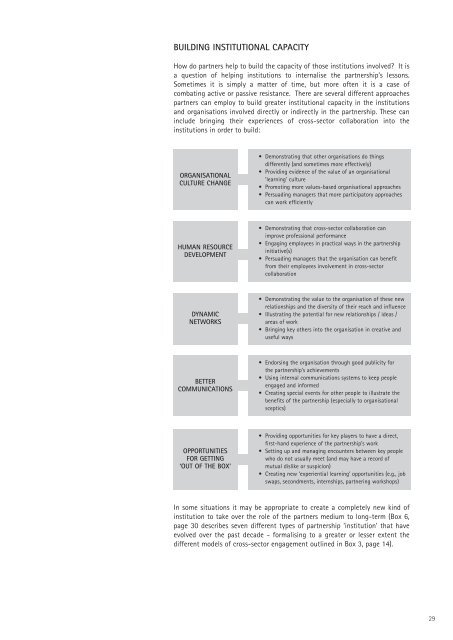Partnering
The Partnering Toolbook - Energize, Inc.
The Partnering Toolbook - Energize, Inc.
- No tags were found...
You also want an ePaper? Increase the reach of your titles
YUMPU automatically turns print PDFs into web optimized ePapers that Google loves.
BUILDING INSTITUTIONAL CAPACITY<br />
How do partners help to build the capacity of those institutions involved? It is<br />
a question of helping institutions to internalise the partnership’s lessons.<br />
Sometimes it is simply a matter of time, but more often it is a case of<br />
combating active or passive resistance. There are several different approaches<br />
partners can employ to build greater institutional capacity in the institutions<br />
and organisations involved directly or indirectly in the partnership. These can<br />
include bringing their experiences of cross-sector collaboration into the<br />
institutions in order to build:<br />
ORGANISATIONAL<br />
CULTURE CHANGE<br />
• Demonstrating that other organisations do things<br />
differently (and sometimes more effectively)<br />
• Providing evidence of the value of an organisational<br />
‘learning’ culture<br />
• Promoting more values-based organisational approaches<br />
• Persuading managers that more participatory approaches<br />
can work efficiently<br />
HUMAN RESOURCE<br />
DEVELOPMENT<br />
• Demonstrating that cross-sector collaboration can<br />
improve professional performance<br />
• Engaging employees in practical ways in the partnership<br />
initiative(s)<br />
• Persuading managers that the organisation can benefit<br />
from their employees involvement in cross-sector<br />
collaboration<br />
DYNAMIC<br />
NETWORKS<br />
• Demonstrating the value to the organisation of these new<br />
relationships and the diversity of their reach and influence<br />
• Illustrating the potential for new relationships / ideas /<br />
areas of work<br />
• Bringing key others into the organisation in creative and<br />
useful ways<br />
BETTER<br />
COMMUNICATIONS<br />
• Endorsing the organisation through good publicity for<br />
the partnership’s achievements<br />
• Using internal communications systems to keep people<br />
engaged and informed<br />
• Creating special events for other people to illustrate the<br />
benefits of the partnership (especially to organisational<br />
sceptics)<br />
OPPORTUNITIES<br />
FOR GETTING<br />
‘OUT OF THE BOX’<br />
• Providing opportunities for key players to have a direct,<br />
first-hand experience of the partnership’s work<br />
• Setting up and managing encounters between key people<br />
who do not usually meet (and may have a record of<br />
mutual dislike or suspicion)<br />
• Creating new ‘experiential learning’ opportunities (e.g., job<br />
swaps, secondments, internships, partnering workshops)<br />
In some situations it may be appropriate to create a completely new kind of<br />
institution to take over the role of the partners medium to long-term (Box 6,<br />
page 30 describes seven different types of partnership ‘institution’ that have<br />
evolved over the past decade - formalising to a greater or lesser extent the<br />
different models of cross-sector engagement outlined in Box 3, page 14).<br />
29


